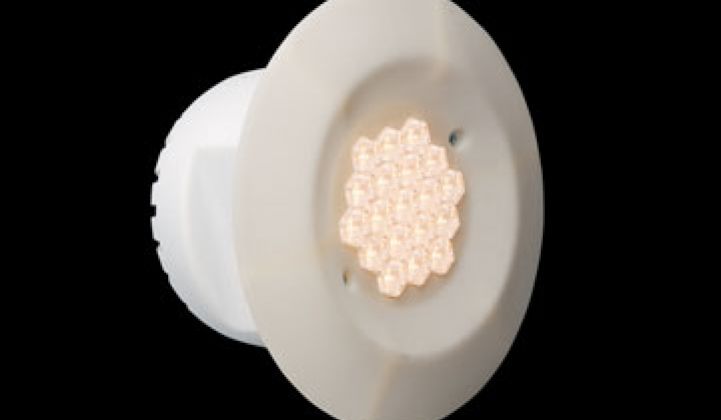General Electric has come out with an experimental LED bulb that is part light fixture and part plane.
Developed in conjunction with professors at the University of Maryland, the LED bulb emits 1,500 lumens of light, about the same amount of light as a 100-watt halogen spotlight, but it requires only about one-third of the energy.
The key to the bulb is a cooling technology called "dual cool" jets. Dual cool jets are tiny bellows that create high velocity air streams that draw heat away from the thermal sinks (i.e., those brushed aluminum objects festooned with fins you see in computers) that surrounding LEDs and other components. Drawing away the heat lowers the ambient temperature. In turn, that lets GE crank up the current on the LEDs. More current leads to more lumen per LED. In the end, it adds up to a bulb that consumes less power than is typical because it relies on fewer LEDs running at higher currents, rather than more LEDs running at a more moderate level.
GE also employs the dual cool jets concept in jet engines and wind turbines. Bulbs, planes turbines: they all benefit from more efficient air flow. GE says this technique increases the heat transfer rate by ten times.
The light from LED bulbs, unlike the light from incandescent bulbs, does not give off heat. LEDs, however, are chips, which convert some of the electricity delivered to them into waste heat. Since LEDs are encased inside bulbs and light fixtures and are often surrounded by metal, wires and even plastics, that heat has to be safely channeled away from its source to prevent mechanical failures.
GE is not the first to step into this field. Nuventix, a Georgia Tech startup funded by Braemar Energy Ventures and others, employs air jets to cool LEDs. It can also deploy its SynJet systems to cool chips inside computer equipment (arguably a more valuable application considering that computers cost more than light bulbs) and data centers.
Berkeley's Progressive Cooling Solutions, meanwhile, has devised a liquid-filled silicon membrane that channels heat from its source. The liquid turns into a vapor after its exposure to heat, gets condensed back into a liquid, and begins another cycle of physical transformation.



